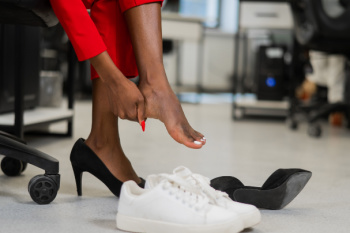Connect With Us
Blog
Items filtered by date: January 2025
See Your Foot Specialist Regularly If You Work On Your Feet
Treating Diabetic Foot Ulcers

Diabetic foot ulcers are open wounds that develop due to skin breakdown, often caused by pressure, friction, or injury. People with diabetes are particularly at risk of foot ulcers because conditions like peripheral neuropathy and poor circulation can impair sensation and healing in the feet. Diabetic foot ulcers can appear on the toes, soles, or ankles and may progress to deeper layers, involving muscles, tendons, or even bones. Untreated foot ulcers increase the risk of infection, potentially leading to severe complications, like gangrene or limb loss. A podiatrist plays a key role in managing diabetic foot ulcers by performing wound care, including debridement to remove damaged tissue and applying specialized dressings to promote healing. They may also recommend offloading techniques, such as using custom footwear or casts to reduce pressure on the affected area. Regular monitoring is essential to catch any early signs of infection or worsening ulcers. If you have foot ulcers related to diabetes, it is suggested that you make an appointment with a podiatrist for regular exams and necessary treatment.
Wound care is an important part in dealing with diabetes. If you have diabetes and a foot wound or would like more information about wound care for diabetics, consult with one of our podiatrists from Foot & Ankle Surgical Group. Our doctors will assess your condition and provide you with quality foot and ankle treatment.
What Is Wound Care?
Wound care is the practice of taking proper care of a wound. This can range from the smallest to the largest of wounds. While everyone can benefit from proper wound care, it is much more important for diabetics. Diabetics often suffer from poor blood circulation which causes wounds to heal much slower than they would in a non-diabetic.
What Is the Importance of Wound Care?
While it may not seem apparent with small ulcers on the foot, for diabetics, any size ulcer can become infected. Diabetics often also suffer from neuropathy, or nerve loss. This means they might not even feel when they have an ulcer on their foot. If the wound becomes severely infected, amputation may be necessary. Therefore, it is of the upmost importance to properly care for any and all foot wounds.
How to Care for Wounds
The best way to care for foot wounds is to prevent them. For diabetics, this means daily inspections of the feet for any signs of abnormalities or ulcers. It is also recommended to see a podiatrist several times a year for a foot inspection. If you do have an ulcer, run the wound under water to clear dirt from the wound; then apply antibiotic ointment to the wound and cover with a bandage. Bandages should be changed daily and keeping pressure off the wound is smart. It is advised to see a podiatrist, who can keep an eye on it.
If you have any questions, please feel free to contact our office located in Henderson, NV . We offer the newest diagnostic and treatment technologies for all your foot care needs.
Plantar Fasciitis and How It Is Diagnosed

Plantar fasciitis is a common foot condition that causes inflammation of the plantar fascia, the thick band of tissue that runs along the bottom of the foot, connecting the heel to the toes. The main symptom is sharp heel pain, especially when taking the first few steps in the morning or after prolonged periods of sitting. The pain tends to decrease with activity but may return after standing for long periods. Common causes of plantar fasciitis include repetitive strain from activities like running, standing for extended periods, or wearing improper footwear. Other risk factors include obesity, tight calf muscles, and flat feet. To diagnose plantar fasciitis, a doctor will conduct a physical examination and may ask about activity levels and footwear. In some cases, X-rays or an MRI scan may be used to rule out other conditions. Plantar fasciitis can cause severe pain and discomfort. If you have heel pain, it is suggested that you promptly consult a podiatrist who can accurately diagnose and treat plantar fasciitis.
Plantar fasciitis is a common foot condition that is often caused by a strain injury. If you are experiencing heel pain or symptoms of plantar fasciitis, contact one of our podiatrists from Foot & Ankle Surgical Group. Our doctors can provide the care you need to keep you pain-free and on your feet.
What Is Plantar Fasciitis?
Plantar fasciitis is one of the most common causes of heel pain. The plantar fascia is a ligament that connects your heel to the front of your foot. When this ligament becomes inflamed, plantar fasciitis is the result. If you have plantar fasciitis you will have a stabbing pain that usually occurs with your first steps in the morning. As the day progresses and you walk around more, this pain will start to disappear, but it will return after long periods of standing or sitting.
What Causes Plantar Fasciitis?
- Excessive running
- Having high arches in your feet
- Other foot issues such as flat feet
- Pregnancy (due to the sudden weight gain)
- Being on your feet very often
There are some risk factors that may make you more likely to develop plantar fasciitis compared to others. The condition most commonly affects adults between the ages of 40 and 60. It also tends to affect people who are obese because the extra pounds result in extra stress being placed on the plantar fascia.
Prevention
- Take good care of your feet – Wear shoes that have good arch support and heel cushioning.
- Maintain a healthy weight
- If you are a runner, alternate running with other sports that won’t cause heel pain
There are a variety of treatment options available for plantar fasciitis along with the pain that accompanies it. Additionally, physical therapy is a very important component in the treatment process. It is important that you meet with your podiatrist to determine which treatment option is best for you.
If you have any questions, please feel free to contact our office located in Henderson, NV . We offer the newest diagnostic and treatment technologies for all your foot care needs.
Foot Injuries From Treadmill Running

Treadmill running can contribute to foot, toe, and ankle injuries due to repetitive stress and strain. Common issues include plantar fasciitis, intermetatarsal neuromas, and Achilles tendonitis. These ailments are often caused by the repetitive motions of running or walking, especially on an incline. They may result in pain in the arch, ball of the foot, or along the back of the ankle. Improper footwear, excessive treadmill use, or pre-existing conditions like tight calf muscles can increase the risk of injury. A podiatrist can assess these conditions through a detailed examination and advanced diagnostic tools. This foot doctor can recommend effective treatments, such as orthotics, adjustments to treadmill routines, or specific footwear advice, to alleviate pain and prevent further issues. If you experience foot pain related to treadmill running, it is suggested that you schedule an appointment with a podiatrist for a diagnosis and treatment options.
Exercising your feet regularly with the proper foot wear is a great way to prevent injuries and build strength. If you have any concerns about your feet, contact one of our podiatrists from Foot & Ankle Surgical Group. Our doctors can provide the care you need to keep you pain-free and on your feet.
Exercise for Your Feet
Exercise for your feet can help you gain strength, mobility and flexibility in your feet. They say that strengthening your feet can be just as rewarding as strengthening another part of the body. Your feet are very important, and we often forget about them in our daily tasks. But it is because of our feet that are we able to get going and do what we need to. For those of us fortunate enough to not have any foot problems, it is an important gesture to take care of them to ensure good health in the long run.
Some foot health exercises can include ankle pumps, tip-toeing, toe rises, lifting off the floor doing reps and sets, and flexing the toes. It is best to speak with Our doctors to determine an appropriate regimen for your needs. Everyone’s needs and bodies are different, and the activities required to maintain strength in the feet vary from individual to individual.
Once you get into a routine of doing regular exercise, you may notice a difference in your feet and how strong they may become.
If you have any questions please feel free to contact our office located in Henderson, NV . We offer the newest diagnostic and treatment technologies for all your foot and ankle needs.
Why Are My Toenails So Thick?

Thick toenails, medically known as onychomycosis, is a fungal infection where the toenails become discolored, thickened, and brittle. The nails may appear yellow, white, or even brown, and can sometimes separate from the nail bed. This infection typically occurs after exposure to fungi that thrive in warm, damp environments, such as sweaty shoes or communal areas like swimming pools. Poor foot hygiene, a weakened immune system, or diabetes can also increase the risk of developing onychomycosis. Symptoms include thickened, misshapen nails, crumbling edges, and a foul odor. If left untreated, the infection can worsen, leading to pain and difficulty walking. A podiatrist is trained to diagnose and treat nail fungus effectively. Treatments may include antifungal medications, topical solutions, laser therapy, or in severe cases, nail removal. Your podiatrist will assess the severity of the infection and recommend the best course of treatment. If you are dealing with this issue, it is suggested that you schedule an appointment with a podiatrist.
If left untreated, toenail fungus may spread to other toenails, skin, or even fingernails. If you suspect you have toenail fungus it is important to seek treatment right away. For more information about treatment, contact one of our podiatrists of Foot & Ankle Surgical Group. Our doctors can provide the care you need to keep you pain-free and on your feet.
Symptoms
- Warped or oddly shaped nails
- Yellowish nails
- Loose/separated nail
- Buildup of bits and pieces of nail fragments under the nail
- Brittle, broken, thickened nail
Treatment
If self-care strategies and over-the-counter medications does not help your fungus, your podiatrist may give you a prescription drug instead. Even if you find relief from your toenail fungus symptoms, you may experience a repeat infection in the future.
Prevention
In order to prevent getting toenail fungus in the future, you should always make sure to wash your feet with soap and water. After washing, it is important to dry your feet thoroughly especially in between the toes. When trimming your toenails, be sure to trim straight across instead of in a rounded shape. It is crucial not to cover up discolored nails with nail polish because that will prevent your nail from being able to “breathe”.
In some cases, surgical procedure may be needed to remove the toenail fungus. Consult with your podiatrist about the best treatment options for your case of toenail fungus.
If you have any questions, please feel free to contact our office located in Henderson, NV . We offer the newest diagnostic and treatment technologies for all your foot care needs.

